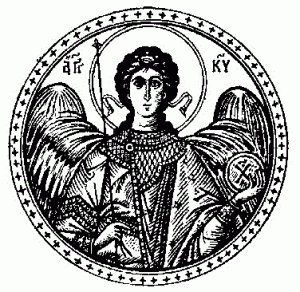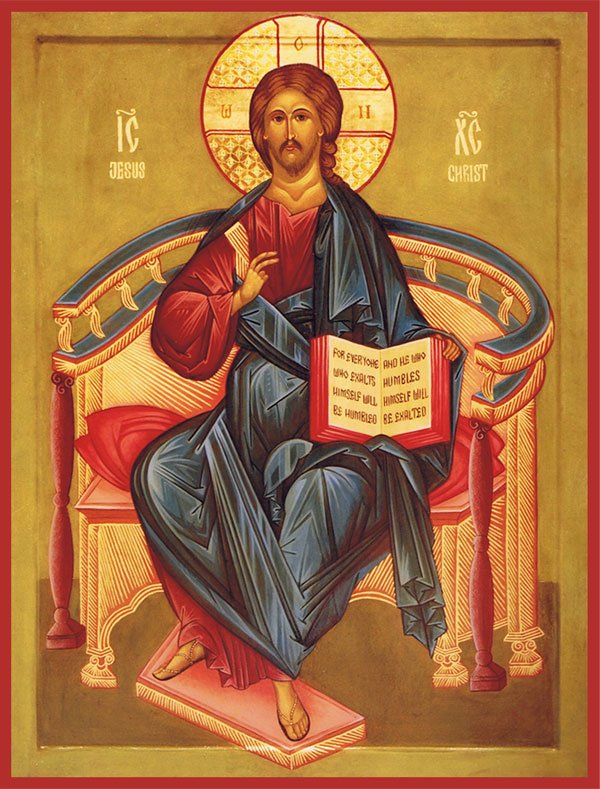A BIG THANK YOU….. Is extended to all those who made our Feast Day celebration such a delightful event. Our Parish Council, which provided the leadership for the event, is to be congratulated. Also a big thank you is extended to all those who attended our Brunch. It made our celebration complete.
Fear is useless; what is needed is trust…
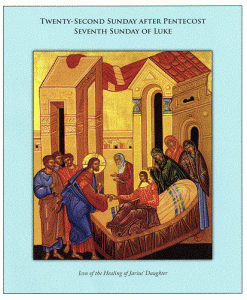 Said Jesus in response to the people who announced that the daughter of the chief of the synagogue was dead. The raising from the dead of Jairus’ daughter, is one of two miracles for women that are coupled in the synoptic Gospels. They are woven into a single account most likely because that is the way that they happened. One the other hand, the number 12 – the age of the girl and the number of years of the woman’s sickness) may have been the literary link for the two miracles being joined together. The number twelve represents, in Jewish Kabbalah, totality, wholeness, and completion of God’s purpose. Further, the name Jairus is a Greek form of the Hebrew name which means he gives light. As a ruler of the synagogue, he was under no obligation to kneel before Jesus, but desperation pulled him to his knees. According to Luke, Jesus had worked a miracle in the synagogue where Jairus was chief. Jesus cured a demoniac there. So Jarius believed that Jesus had the power to cure his daughter and approached Him. There is no indication to which religious party Jarius belonged.
Said Jesus in response to the people who announced that the daughter of the chief of the synagogue was dead. The raising from the dead of Jairus’ daughter, is one of two miracles for women that are coupled in the synoptic Gospels. They are woven into a single account most likely because that is the way that they happened. One the other hand, the number 12 – the age of the girl and the number of years of the woman’s sickness) may have been the literary link for the two miracles being joined together. The number twelve represents, in Jewish Kabbalah, totality, wholeness, and completion of God’s purpose. Further, the name Jairus is a Greek form of the Hebrew name which means he gives light. As a ruler of the synagogue, he was under no obligation to kneel before Jesus, but desperation pulled him to his knees. According to Luke, Jesus had worked a miracle in the synagogue where Jairus was chief. Jesus cured a demoniac there. So Jarius believed that Jesus had the power to cure his daughter and approached Him. There is no indication to which religious party Jarius belonged.
Luke’s account does not include the child’s name and he has Jesus tell the girl’s parents, after raising her from the dead, not to tell anyone what had happened. This seems strange since people had already told Jesus that the girl was dead. This was the first time that Luke includes reference to the Messianic Secret – to the fact that Jesus frequently told those He cured to tell no one except, perhaps, the priests. Since these two miracles were among the first that He performed, there was no awareness that He was the Messiah and the accounts were written after His death and resurrection.
What message can we derive from these miracle stories that can help us live our lives more completely today? What can we glean from them that will help us on our spiritual journey?
Two things immediately come to mind. First, the meaning of the number 12: earthly life is a completion of God’s purpose to help us develop a relationship with Him. And second, the meaning of Jarius’ name in connection with the number twelve: God is the one who gives us light – insight – into the meaning and purpose of life.
If we are not afraid and trust in the Good News that God has given us through Jesus, we will have life in its fullness. Fear about the future is absolutely useless! We cannot change the future by our worrying or being anxious. What will be will be! Trust, however, in the love of God for us will help us deal with anything that life presents.
So the message I have derived from this week’s Gospel is:
Fear is useless; what is needed is trust!
In the last issue of this article, we began looking at the Letter to the Colossians. One of the letter’s most striking passages speaks of the cosmic Christ; that is, its language about the status and significance of Jesus transcends his historical life and goes back to the beginning of creation, the cosmos. Pick up the letter and read chapter 1, verses 15-20.
You will find that these extraordinary statements affirm in slightly different language what we find in the first chapter of John’s Gospel. There Jesus is the Word of God become flesh, the Word who was in the beginning with God and through whom God created everything. Here, Jesus is the image of the invisible God and in him all the fullness of God was pleased to dwell. As the firstborn of all creation, all things were created through Him and for Him. Through Him and His death all things on earth and heaven have been reconciled. As in John’s gospel, this is incarnational theology: in Jesus, we see what God is like.
Think about this and what is also shared about the Person of Jesus in the article about the Fathers of the Church (page 8).
Many scholars think this text is an early Christian hymn used and perhaps adapted by the author. If so, these affirmations are earlier than Colossians and shared by other developing streams of Christian traditions such as what we will find in John’s Gospel.
The author also cautions the community about the teachings and practices advocated by unnamed teachers. There is no scholarly agreement about who they were. But the author’s message is clear: live the life you see in Jesus.
The author then names the things that one must do in the name of Jesus. (read 3:12-17).
The letter then closes in chapter 4 with final words of advice and greetings. Specific persons are named. This specificity is one of the major reasons why some think Paul himself wrote the letter. But if Paul didn’t write this letter, what are we to make of the specificity of the greetings? Was it part of a deliberate forgery – was somebody deceitfully and maliciously pretending to be Paul? Or was it a follower of Paul seeking to adapt his message to a latter generation? Is Colossians an extension of Paul’s thought? Or the beginning of a subversion of Paul’s radicalism? The jury is still out.
Regardless of who the author is of this letter, the Church regards is as inspired – prompted by God’s Spirit to be written – and has a message for us. Some scholars believe that the letter was written by Epaphras, one of Paul’s Ephesian converts and a member of the Colossian Christ-Community.
Take time to read it!
In the last issue of this article, I ended my thoughts about the spiritual journey that we humans are called to make by commented on the fact that Mary, the Mother of God, also had to make such a journey. She experienced her call as a gradually unfolding process, a journey, not unlike the one we are called to make. Because she was human, she made the same journey that we are called to make. We sometimes picture Mary, because she played the role of the Mother of God, as someone why didn’t have to endure the same life struggles that we do. On the contrary, she experienced all the things that we experience. The picture of her life was not clear to her.
In most journeys, the end is not determined by the way one gets there. If New York is the destination, when a person arrives, it makes little difference whether he or she flew, took the train, drove or walked. New York is still the same. But the spiritual journey is different.
In fact, the journey is more important than the destination since it is in the journey that we must make that we have the opportunity to transform our lives. In fact that is why life is a journey. As we travel along through life, we encounter multiple ways to change our minds and hearts because of the various things that we experience.
In one view of the spiritual life, what comes after death is all-important, and the goal of life is getting through the pearly gates, even if it is a last-minute dash. But when we see the spiritual life as a journey, the way we live each day is all-important, because we see life after death as a continuation of the way we live our relationships with ourselves, with others and with God.
There is nothing in my studies or experiences that makes me believe that life after earthly death is static, that is never changing. All living and created things are dynamic, that is ever-changing. Look around you. The entire universe is constantly in flux and changing. Why? Because it is alive! That is why I believe that the view of the spiritual life as a journey is so very appropriate. We will be on this journey for all eternity. It would be horrible, at least in my estimation, if things never changed for all eternity. I believe we would become quickly bored and discontented.
Many people see their lives as a series of isolated incidents with no direction. Only you yourself can determine the direction even though you have to go through many changes. If your goal is to enter ever deeper into a real and true relationship with God, then that will provide direction to your life. When all things are seen through this prism, life can become an exciting journey!
In the last issue I presented Justin’s basic format the early Church used to celebrate the Divine Liturgy. If you compare later liturgical developments to Justin’s first format you will find that the evolution respects this primitive outline in what has been called the fourth period of growth and then later violated.
During the fourth period of the Liturgy’s development, as I presented it, we find a basic filling in of the common outline at the three soft points in the outline: (1) before the readings, (2) between the readings and the Eucharistic prayer, and (3) at the communion and dismissal. Note that at the primitive Liturgy these are the three points of action without words: the entrance into the worship space or the assembling of the Church; the kiss of peace and transfer of gifts; and the faction, communion and dismissal rites. What could be more natural than to develop the ceremonial of these actions, cover them with chants and add to them suitable prayers? For one of the most common phenomena in later liturgical development is the steadfast refusal to let a gesture speak for itself.
This process often took the form of the permanent addition to the service of rites and ceremonies which in origin hand an exclusively locale scope in the festive rites or a particular time and place. When added to the Eucharistic rite as permanent integral parts, they inevitably lose their original connection to the religioustopography of their place of origin and, hence their original scope and meaning. They assume a life independent of their past. This too is a common occurrence in liturgical history. It is especially noticeable in the rites derived from cities where liturgy was stational (the Liturgy was, in effect an active procession from one location to another, albeit, each city may have done it is a slightly different manner. Processions with all the people involved played an integral part of the Liturgy – life truly was a journey or procession of faith): Rome, Jerusalem, and Constantinople, the three most important centers of liturgical diffusion in the period after Chalcedon (451).
As ceremonial and text rush in to fill the vacuum at the three action points of the liturgy, thus overlaying the primitive shape with a second stratum of entrance, pre-anaphoral and communion rites, a contrary movement is provoked. The liturgy, thus filled out, appears overburdened and must be cut back. Now what is fascinating about this next step is the abandonment of the former respect for the primitive shape. For it is universally verifiable that the elements thus reduced or suppressed are never the later, secondary, often questionable additions but elements of the original core, for example, Old Testament readings
This article is dedicated to helping my readers develop their spiritual lives. One of the possible approaches is to reach out to God through prayer. As I suggested, there are several forms of personal prayer. One is reciting prayers that we have memorized. Periodically we need to renew the practice of saying prayers. However, merely reciting the words can degenerate into mumbo jumbo, the kind of babbling in prayer against which Jesus warned. We often find, unfortunately, that we tend to rattle off the prayers that we know. Periodically I think it is important that during the Divine Liturgy we slow-up reciting the prayers, especially the Creed. The Creed recites all the basic beliefs we have as Christians. It should not be rushed. We should think about what it is that we believe. Saying special formulas a specific number of times can be a way of trying to manipulate divine power to get something, rather than being a genuine reaching out to God. If said prayers become a mindless recitation of words or if they assume a magical quality, we will stunt our spiritual growth and make little or no progress on the spiritual journey.
The key to transforming familiar prayers into more than an automatic recitation of words is taking time to consider what we are saying. We have to note where our heart is when we say them. The Lord’s Prayer, which most of us have learned before we were capable of truly understanding the depths of meaning in it, can be rediscovered by saying it thoughtfully and slowly, savoring the meaning of the words. When we join the human experiences of suffering, loss, or joy to the slow and thoughtful praying of the Lord’s Prayer, our eyes will begin to see new dimensions of God’s will and of the coming of God’s rule in our lives. We will become more trusting of God’s daily care for us. We will realized that God forgives us and that an essential condition for the spiritual journey is that we forgive others. In fact, we may find that it is the best and most comforting prayer we can say.
During this past week, November 8th, our Church celebrated the feast of the Synaxis of St. Michael the Archangel. This feast also includes the rest of the Angelic Powers. It is perhaps in the Divine Liturgy that the sense of the presence of the angels is most keenly felt. As the holy gifts are carried through the church from the Prothesis (Table of Preparation) to the Holy Table, we sing the Cherubic Hymn. And when we come to sing the thrice-holy hymn in the eucharistic prayer, we recall the thousands of Archangels and tens of thousands of the angels, the Cherubim and the Seraphim. So as we come into the presence of God, pre-eminently in worship, we are made aware of the presence of the angelic hosts that stand before God. It is as if the angels are the sparks that fly off as God and His creation encounter each other.
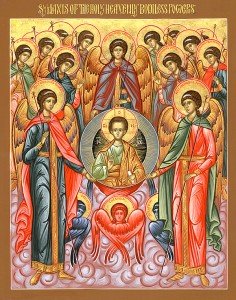 The feast in honor of St. Michael and all the other angelic hosts was established in the fourth century. This feast is called a synaxis (assembly) because on this day the Church celebrates the assembly of all the bodiless powers together with St. Michael, Chief of the heavenly hosts and the assembly of the faithful on earth who gather together to pay homage to the heavenly powers.
The feast in honor of St. Michael and all the other angelic hosts was established in the fourth century. This feast is called a synaxis (assembly) because on this day the Church celebrates the assembly of all the bodiless powers together with St. Michael, Chief of the heavenly hosts and the assembly of the faithful on earth who gather together to pay homage to the heavenly powers.
We celebrate the Synaxis in November because formerly, when the year began with the month of March, this month was the ninth month in the year and so it bore a symbolic relationship to the nine choirs of angels. The nine ranks of angels are: Seraphim, Cherubim, Thrones, Dominions, Powers, Authorities, Principalities, Archangels and Angels. Fathers of the East and West showed their approval of angelic cult and testified to its early existence. The earliest known devotion to angels was principally centered on the Archangel Michael, the only individual angel honored in liturgical feasts in the Church before the 9th century. In the East, Michaeline devotion was evidenced by the fourth century in the churches and sanctuaries in and near Constantinople.
The Christian concept of angelic cult is verified only in practices of genuine, divinely revealed, religion and has no equivalent in pagan cults associated with angels. The Old Testament offers some manifestations of angelic cult, but such practices did not constitute the principal object of prophetic teaching; not did people, though conscious of angels, consider their existence relevant. In the New Testament, the Gospels mention angels but do not specifically recommend or reject devotion to them. St. Paul implicitly teaches veneration of angels but such cult is to be given in a manner that does not derogate from Christ, the one and unique mediator. Paul showed displeasure at false or exaggerated cult to angels. Angels are part of the invisible world that we profess exists in God’s creation.
While I am quite aware that at times this article may be quite challenging because of how the Fathers of the Church thought and wrote, I have several hopes in sharing this information and how the Church has struggled through the centuries to come to an understanding of what she believes about our relationship with God. The dogmas of our faith were only formulated after much debate and a whole lot of thought. There was real concern that what the Church asked people to believe was as true as we humans can understand.
My first hope is that my readers will develop a much greater appreciation for our religion. My second hope is that my readers will develop a deeper understanding of the things that we believe, especially our beliefs about Jesus Christ, God Incarnate. Indeed the very thought that God could become a human being without either diminishing His Godhead or being not truly human as you and I are, is a complex idea. I’ve been presenting the ideas that the Fathers considered in coming to the belief that Jesus is truly God and truly man.
It is extremely important that we believe that Jesus is truly human. If He wasn’t truly human, then He could never have been a model for us on how to live. While the Council of Chalcedon insisted that Christ was indeed one in His personal identity, it did not clearly specify that the term hypostasis, used to designate this identity, also designated the hypostasis of the pre-existing Logos (i.e., Word of God). The anti-Chalcedonian opposition in the east so built its entire argument around this point that Byzantine Christology of the age of Justinian committed itself very strongly to excluding that interpretation of Chalcedon which would have considered the hypostasis mentioned in the definition as simply the union of the old Antiochian School (i.e., the synthetic reality resulting from the union of the two natures). It affirmed, on the contrary, following Cyril of Alexandria, that Jesus Christ’s unique hypostasis is the pre-existing hypostasis of the Logos; that is, that the term is used in Christology with exactly the same meaning as in the Trinitarian theology of the Cappadocian Fathers: one of the three eternal hypostases of the Trinity took flesh while remaining essentially the same in its divinity. The hypostasis of Christ, therefore, pre-existed in its divinity, but it acquired humanity by the Virgin Mary.
This fundamental position has two important implications: (a) there is no absolute symmetry between divinity and humanity in Christ because the unique hypostasis is only divine and because the human will follows the divine. It is precisely a symmetrical Christology which was rejected as Nestorian in Ephesus (431).
As you can tell, it is not easy to conceive how God could become man.
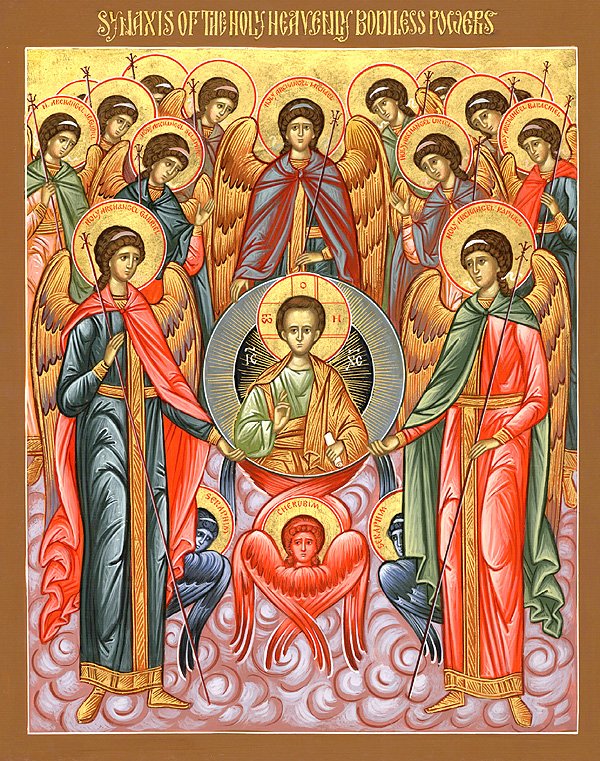 Synaxis of the Archangel Michael
Synaxis of the Archangel Michael
and the Other Bodiless Powers
O Supreme Leaders of the heavenly armies, * we, who are unworthy, ever beseech you, * that by your prayers you protect us * with the wings of your immaterial glory, * watching over us, who fervently fall down and cry out: * “Deliver us from perils, * for you are the commanders of the Powers on high!” (Troparion, Tone 4)
O Supreme Leaders of the armies of God, * and ministers of the divine glory, * princes of angels and guides of men * ask for what is expedient for us, and for great mercy, * for you are the the Supreme Leaders of the Bodiless hosts. (Kontakion, Tone 2)
Go back home
and recount all that God has done for you.
Of all the miracle stories in the canonical Gospels, this one comes closest to the type found in the apocryphal Gospels. Although found in all three Synoptic Gospels, scholars tell readers that they should not make an attempt to reconstruct what really happened. The actual facts of the story are not important. What truly is important is what the Gospel writers were attempting to communicate by the story.
Consider the story. It takes place outside Jewish territory and is associated with Jesus’ Galilean ministry. Since the Gospel accounts were written after Paul’s missionary activities, we see that this supports the contention, which was then supported by Peter, that Jesus came to share the Good News with all humans. In fact the story suggests that Jesus recruited this Gentile as one of his first “evangelists” saying: Go back home and recount all that God has done for you. The Gospel writer wanted to share this same exhortation with his readers. We do well to hear this exhortation as directed to us as well as the man in the story. We need to share with others what God has done for us. Perhaps in simple terms this might mean for us to count our blessings and give glory to God.
The story also suggests that Jesus had power over the spiritual as well as material world. He deals with demons. The story has the demons recognize Jesus’ power to order them back to the abyss – the abode of the dead. It is interesting how Jesus deals with them. He consents to their request to be sent into the herd of swine. This, perhaps, is the most puzzling part of this story. Why would Jesus consent to do what they requested? First, the story tells us that Christians should treat demonic power as nonexistent. Second, it tells us that the only place appropriate for demons is within pigs, animals which, according to Jewish custom, were unclean.
The story also tells us something about the power of knowing the name of a person. There is real power in knowing a person’s name and not treating them as insignificant. You will recall in the story that the demons are represented as having known Jesus’ real name and then Jesus discovering the name of the demons. The Gospels state that the disciples were able to cure people in the name of Jesus. In Eastern Christianity the name JESUS is seen as powerful. The traditional Jesus Prayer supports this assertion. We do well to call upon Jesus to drive out from our hearts any evil spirit that might dwell there. Our Baptismal service suggests: any evil spirit of deceit, wickedness, idolatry, greed, lying and impurity.
When we give into prejudice, bias and judgment of others, these evil spirits seem to find ground to flourish in our lives. Let us ask Christ to drive them out!

